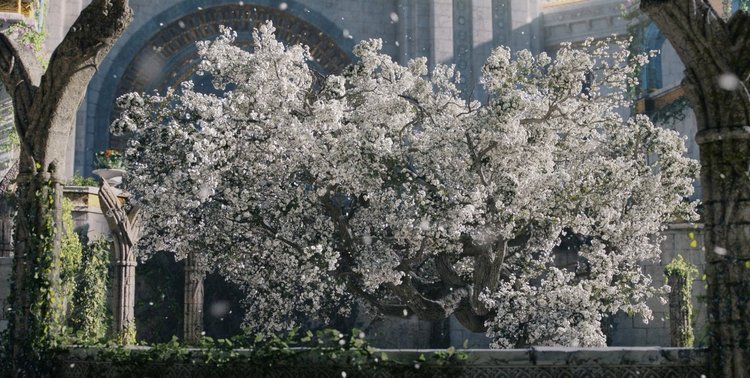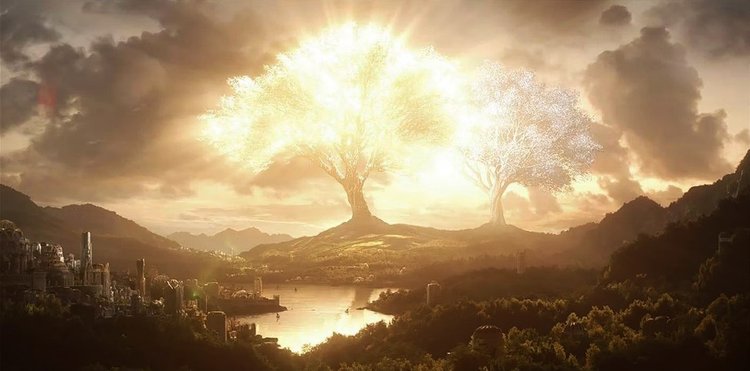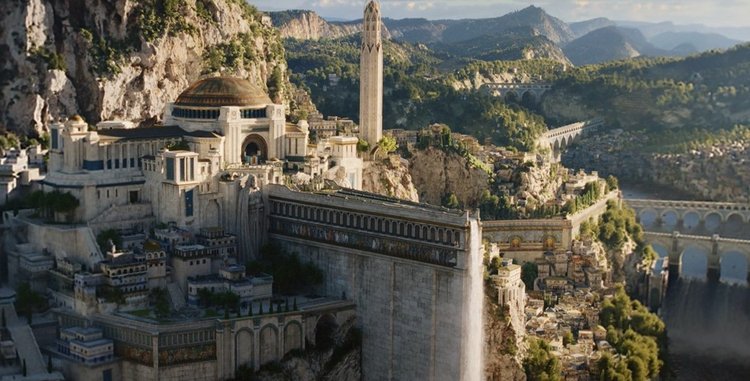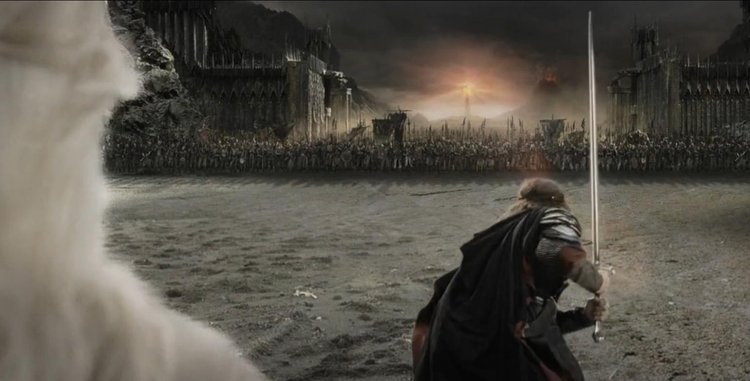Macrobius
Megaphoron
For whatever interest:

Statue of Eärendil (Lucifer) in the island of Númenor, the Atlantis of Middle-Earth. Eärendil carries the last of the Silmarils, and as he sails across the sky it becomes the Morning Star (Venus). Through their progeny, Eärendil became the ancestor of the Númenorean, and later Dúnedain, the royal bloodline of King Aragorn.
Yet at the last, in the wearing of the swift years of Middle-earth, Gondor waned, and the line of Meneldil son of Anárion failed. For the blood of the Númenóreans became much mingled with that of other men, and their power and wisdom was diminished, and their life-span was shortened, and the watch upon Mordor slumbered.
The Sillmarilion, by J.R.R. Tolkien
The firstborn and the followers
In the Silmarillion, Tolkien describes the First Age of the world, where the creation of Arda is manifested in all its splendor. The Elves, the first beings created, are "the fairest and wisest of all beings"; wonderful creatures endowed with extraordinary beauty and divine attributes incomprehensible to mortals. We are talking about the Hyperboreans of the Primordial Gnosis, the Tuatha Dé Danann of Celtic mythology; a very ancient and superior race, "beautiful, wise and totally pure". The blood purity of the Firstborn allows them to communicate directly with the Valar, the guardians of the 'Flame Imperishable' who only welcome those who are worthy. Sometimes, the loss of this virtue will cause their misfortune. We see then how Tolkien insists that the Elvish race had the best spiritual and genetic heritage in Middle-Earth. After the Primeval Age, the Race of Men appeared, less noble and virtuous than the Elves. However, they are solar creatures, for they appear simultaneously as the great lights of the firmament.The Elves, the "firstborn Children of Ilúvatar" in Tolkien's Legendarium, would be "the ones who fell from Venus" of the Hyperborean Wisdom, that is, from the Morning Star (Earendil-Apollo-Lucifer). The Demiurge Morgoth seeds war and disintegration among the "race of the stars", causing great calamities and producing the exodus of many of them out of Valinor, the Undying Lands, towards Middle-Earth. According to the Primordial Gnosis, the current Aryan Race is the last remnant of the Hyperboreans, semi-divine giants who were forced to migrate initially from Thule-Hyperborea, the furthest polar north, towards the southern lands of Europe, reaching Mount Elbrus and founding the kingdom of Asgard in the Caucasus. From there, the Aryan-Caucasian race would birth to the world's oldest civilizations. The ancestors of the peoples of the Peloponnese entered Europe from the Caucasus through the Greek islands in the Aegean; founding Troy and Atlantis, the main references of the Ancient Greek splendor. The first humanity had experienced beauty, glory and majesty never witnessed nor replicated. Unfortunately, they will fall into "racial sin" by mixing with "inferior men" and the mythical Golden Age would never be recovered.
Perhaps the most difficult aspect to assimilate in Tolkien’s books is the racial allegory contained in its pages. For example, the line of the kings of Númenor (Atlantis) descended not only from elves and men but also from the Maiar. After their Downfall, their blood purity gradually decayed, progressively withdrawing their gifts of wisdom, nobility, and long life. The more significant their racial mixture, the shorter their lifetime. In this aspect, Tolkien's writings coincide with the involutionist theory of Gobineau. In "Essay on the Inequality of Human Races", he predicted: "The era of plenitude, in which the Aryan-Hyperborean race lived in a state of purity, is followed by an era of progressive decline. Human history has been divided into two periods: one that has already passed and would have seen and possessed the youth, vigor, beauty and intellectual greatness of the species, and another that has begun and will know the faltering march of humanity towards total decrepitude". The current mankind, cursed by racial and social decadence, will be reduced to feebleness and diminished to a vanishing point, passing away as the shadows of the Flame of Anor.
Light and darkness in Tolkien's Legendarium

Nimloth, the White Tree of Númenor; symbol of the Númenóreans' strength and loyalty to the Valar. It was cut down at the instigation of Sauron during the Downfall and its wood was used to light the first flames in the fire of the new religion which worshipped Melkor.
The Ainulindalë describes the Creation of the World by Eru Ilúvatar "the first of things, quintessence pure" and the choir of his angelic offspring, the Ainur. To suppose what this music would be like, the only reference we know is the genius of Bach. The divine harmony was absolutely perfect until Melkor broke it by proposing his dissonant "music". From it emanated chaos, disorder and ugliness. Melkor is selfish, disobedient, and arrogant, always eager to disrupt and tear down what the divine have built. He embodies the destructive Satanic principle that seeks to twist and obscure all forms and meanings. Something similar is described in the Primordial Gnosis. Before time was created, there was a unique divinity, the Unknowable God, a transcendent entity completely outside and beyond the world; "the Timeless Halls." From his inextinguishable being emanated the Aeons, celestial beings that order the spiritual plane through the Music of the Spheres. One of these Aeons, Yaldabaoth, the Demiurge Jehovah-Satan, will rebel by breaking the cosmic harmony and establish our material world, a realm of duality and decay.
Like the Demiurge itself, Melkor cannot create anything on his own; it only twists and defiles something divine and pure into a corrupt shadow of its former self. For example, the Quendi who fell into the hands of Melkor were put in prison, and through the slow arts of cruelty, that is, genetic manipulation, they ended up corrupted and enslaved. Miguel Serrano writings alludes to something similar; when the Aryans began to expand throughout the world, one of those clans, the Eber, also called Habiru or Israelites, were seduced and genetically manipulated by the Demiurge. From now on, they will no longer be Aryans but at the service of the dark entity. In the glorious days of Númenor-Atlantis, the righteous kings worshipped Eru Ilúvatar at the Sacred Mountain Meneltarma. Everything changed in the dark days; the profane kings avoided it and offered burnt offerings in Melkor's temple; "Thereafter the smoke and the fire went up without ceasing" (Akallabeth). As YHWH-Baal, Melkor is also a lover of blood sacrifice and burnt offerings. The Númenorian worship of the Demiurge led to their downfall, when their island-home was covered by the sea, as a divine punishment from the Valar.
All suggest that J. R. R Tolkien's writings, whether consciously or not, are intended to represent a gateway of Gnosticism. The Created World derive from the initial polarization of Melkor-Demiurge, which breaks the primordial unity of all things to form the universe. From this act come such polar opposites as space and substance, inner life and outer form, positive and negative, and good and evil. Those are the primal forms of leitmotifs that recur throughout the history of Tolkien's Middle-Earth. In this world of duality, the brighter the Light, the deeper the Shadow. One cannot exist without the other. In the perpetual struggle against evil, humanity reveals its beauty by reaffirming an existence with meaning, virtue, and hope. Tolkien's One Ring, the ultimate symbol of evil, acts as a triggering mechanism to unleash the shadow when anyone possesses it or desires it. No one, not even a great wizard or elven can wear the One Ring without being corrupted by its seductive powers. The shadow is revealed in the desire for power, greed, selfishness, pride, and lust. The Ring is a commitment to the illusion of matter (Maya) that ends up erasing mankind from its humanity.
There is no hope without despair, nor progress without struggle; we cannot reach enlightenment without facing our shadows (not by 'touching the darkness' as the Amazon's TV series suggests). This concept is critically important in those who follow a spiritual path. It is the main reward of the Gnostic path of initiation. Beyond the labyrinthine halls and passages of the mines of Moria, filled with hidden menaces of all kinds, Gandalf and the Fellowship faced a Balrog, an ancient devil at the service of Morgoth. As the Istari faces the Demon, he declares, "I am a servant of the Secret Fire, wielder of the flame of Anor". The word "anor" is the Sindarin word for "Sun". Gandalf stands as a light-bearer against the ultimate corruption of fire and 'dies' in the attempt. His spirit enters the Outer Void, only to reappear later on in the tale as "Gandalf the White", a step closer to his holy form as one of the Maiar. Recalling his ordeal, he says: "Then darkness took me, and I strayed out of thought and time, and I wandered far on roads that I will not tell. Naked I was sent back—for a brief time until my task is done." Gandalf becomes a "twice born" or "illuminated one" with the sacred mission to restore the 'fire unperishable' in Middle Earth.
The fear of Death becomes enslavement. Tolkien believed that extending life indefinitely, as the One Ring does, is not a true escape from death, it is a mockery of eternal life.
Death is not a divine punishment, but a gift, given exclusively to men by the Valar, in order to make them transcend to eternity. Nimrod's Fundamentals explains that the Eye of Abraxas generates Maya (illusion): the experience of time and death, the seething darkness beneath reality. Only the Virya (warrior) who transmutes himself can escape from the Great Deceit. Transcendence (Kairos) is generally achieved on the battlefield, because it is the moment in which the spirit attempts to break free and reveals the secret of Maya. If the Warrior dies, he wins the eternity of Valhalla. During the Battle of the Pelennor Fields, the Rohirrim fulfill the Blood Pact and come to the aid of the Gondorians, besieged by the anti-races. There, Éomer cries "Death! Ride, ride to ruin and the world's ending!" after he goes berserk. He orders a reckless charge, and the Riders cry "Death!" with one voice. The scream of "Death!" goes beyond than an epic war chant, it is a direct defiance to evil, a total rebellion against the Great Deceiver.
The Elves lament the spiritual and physical corruption of Arda. They live in hope (Estel) that one day this damage will be undone and the world will be purged of all evil, restoring it to a paradise state. According to a prophecy, after the Dagor Dagorath, the Last Battle at the end of days, a Second Music of the Ainur will be sung, forming a new world, called Arda Healed. It will be the fulfillment of a perfected world that would have been were it not for the intervention of Morgoth.
The Tree and the Blood's Memory

Telperion & Laurelin, the Two Trees of Valinor; both spreading silver and gold light in the Undying Lands. When these are destroyed, their last fragment of light is made into the Silmarils, and a sapling too is rescued, leading to the White Tree of Númenor, the living symbol of the Kingdom of Gondor.
Tolkien believed in the possibility of ancestral memory regression. He frequently stated that he did not invent his stories but rather "recorded" or "reported" what was already there. This theme returns in his letters in which he describes an uncanny and recurring dream of a Great Green Wave, the inspiration behind the sinking and downfall of Númenor. Tolkien's son Michael had the same dream, and that made Tolkien speculate that they both accessed an ancestral racial memory about the destruction of Atlantis. Myths are not hereditary; what is acquired is the archetypal memory with which the myths are built. Unless we accept that memory does not reside in the brain but in the Higher Self and that only the inspired writer is able to contact these memories, Tolkien's profound ocean of inspiration and knowledge remains inexplicable. One mysterious visitor to the author's home is said to have asked him: "you don't really think you wrote all those stories, do you?" Tolkien's had no reply, but the question probably gave him much food for thought.
A recurring theme in Tolkien's writings, so much so that it becomes sacred, is that of the Tree archetype. No one has insisted so much on this element as Tolkien. Just like the elves, the memory of "paradise lost" is always in the minds for the Hyperborean descendants. The two trees of Valinor, Telperion and Laurelin, are equivalent to the Two Trees in the Elysian Fields, Hesperios and Eosphorios; one of them distils soma, the drink of memory, and the other ambrosia, the elixir of immortality. The Great Tree of Gondor, whose branches bear no bud, has an ancient origin in Nimloth, the great White Tree of Númenor. At the end of the Third Age, Aragorn ascends the throne of Gondor; he does so because he is a Dúnedain, the heir to the oldest and longest Númenórean royal lineage. Aragorn is king because he is the last direct descendant of the White Atlanteans; his blood is the purest to establish a link with his racial past. This fact alone makes the White Tree bloom again.
Another relationship between the Racial Akashic record can be found in the Sillmarils, three sacred jewels which contain the light of the Trees of Valinor. The jewels, whose radiance shone like the stars, are an artifice of the divine origin; they give form to the light of eternity in the world, the light of eternal life. They are analogous to the Venus Stones described in Belicena Villca, which allow the ‘reflection of the divine origin illuminating the inner life of the spirit’. They burn with an imperishable inner light from the eternal World. We are dealing with a dimension of being akin to the divine Logos, Plato's intelligible world. The Graal (Philosopher's Stone) affects those who bear something of the eternal spirit within them, due to their spiritual lineage and degree of Blood purity, that is, due to the quality of their Minne. Only those who remain pure can perceive it to a greater or lesser extent, since they had preserved in their blood the Vril, the memory of their Hyperborean ancestors.
The Oera Linda and other sources

In Númenor there was growing discontent about the Ban of the Valar, questioning the Gift of Men and becoming envious of the immortality of the Eldar. They were coerced by Sauron to assault the Undying Lands, which ultimately led to the island's destruction.
All the lore, mythology and original languages of Tolkiens' Middle Earth were influenced by the narratives of codexes and ancient manuscripts. Some of them are the Finnish saga Kalevala, the Elder Edda (Poetic) and the Younger Edda (Prose), Beowulf, and the Volsung Saga, later re-told in the Germanic Nibelungenlied. It is possible that Tolkien read texts as old as the Wurzburg Codex of 700 before our era. Some of those manuscripts, such as The Mabinogion, are reminiscent of Tolkien's Red Book of Westmarch (the presumed source from which the trilogy came). Also, The Book of Ballymote, which narrates the myth of the Tuatha Dé Danann, the main inspiration behind the history of the Eldar. It is also very possible that some of these ancient texts were influenced by an odd manuscript found in Holland in 1871, known as the Oera-Linda, written in Liuwert in the year 3449 after the Sinking of Atland-Helgoland (Númenor). The book reveals that historical Atlandia sank around 2193 B.C.
The Ages of Middle Earth expose a profound vision of the myth of the eternal spiritual descent of the White Race. This concept has been kept hidden in secret Aryan brotherhoods for centuries and only had come to the surface through the disguise carefully provided by authors and poets, such as Goethe, H.P. Lovecraft, Lord Dunsany, Eric Rücker Eddison, Robert E. Howard, Edgar Allan Poe, and Herman Melville, among many more. Of course, we are not only talking about a contemporary phenomenon since the great classics such as Dante, Virgil, Cervantes, Homer, etc., also provide us with a vision of a superior Primeval age starring semi-gods and heroes. It should not surprise us that so many authors so distant in time and space have come to similar conclusions on their own. There is a spiritual link that unites all these authors; they were repositories of certain mysteries inherited in the Blood's memory. Perhaps the English writer Edward Bulwer Lytton was the most explicit when referring to the subject of the Hyperborean race and the Ages of Men. Among his best-known works are: The Last Days of Pompeii and Rienzi. But it is in The coming race, where he predicts the End of Days on a corrupted Earth's infected by miscegenation, by the hands of the inhabitants of Agartha.
Tolkien's spiritual legacy

Aragorn leads the army of the West as he charges against Sauron at the Battle of the Black Gate. Tolkien's legendarium ends with a vision of the end of the world, a final battle which owes, evidently, to the Norse vision of Ragnarök.
Myths are beyond allegories; they describe eternities beyond human life, revealing ineffable truths which cannot be intellectually reasoned. Jung notes that the ultimate source of myths is archetypical, and archetypes are representations of the metaphysical. Great literature is inevitably mystical, it communicates imprints of higher realities and elevates the higher self from the mundane 'reality' to an ultimate inner experience. Tolkien confessed to his friend W. H. Auden sometimes felt that he was not so much building characters and a world out of his own imagination but rather discovering an inhabited world that already existed. In an age of materialism and skepticism, fantastic literature represents the bridge towards the transcendental and immaterial origin. Tolkien's writings, with imaginative and intellectual beauty, reveals the invisible realm long forgotten and recovers the light of the spiritual world, challenging the modern taught to distrust imagination and view romance as a kind of pathology.
Tolkien's Cultural phenomenon may be the last attempt of the archetypal myth of the Collective Unconscious of the White Race to call up its last offspring, the saplings (if they still exist) of the great White Tree. And it is that The Lord of the Rings has become one of the best-loved novels of all time. Most are blinded by the splendor and magical charm of a fabulous story but nothing more. Others, for obvious reasons, do not find any link or affinity with that order of things. Finally, the rarest are those who hear Rohan's horn calling from Mythical Hyperborea. Epic, Fantastic literature affects, above all, a certain type of reader in particular; the one who, perhaps without knowing it, possess the Blood's memory and can, at a certain moment, remember what he or she is reading.
J.R.R. Tolkien offered the vision of an ancient and majestic world when the Earth was young, and the Hyperborean ancestors dominated the world. The myths of Middle-Earth become the remnants of the Golden Age that awaken in us deep and hidden truths, making their way through the censorship and oblivion of the Modern Age. Miguel Serrano says, referring to the books of his friend Herman Hesse: "As happens with men, so also happens with books. There is a destiny for them; they are as if guided towards the beings that await them, arriving at the precise hour. They live, they die and reincarnate; they are built of pulsating matter, which seeks and makes its way through the shadows and thickets, often beyond time and beyond their authors."
Brothers shall fight and fell each other,
And sisters’ sons shall kinship stain;
Hard is it on earth, with mighty whoredom;
Axe-time, sword-time, shields are sundered,
Wind-time, wolf-time, ere the world falls;
Nor ever shall men each other spare.
The Poetic Edda
- 30 -


















